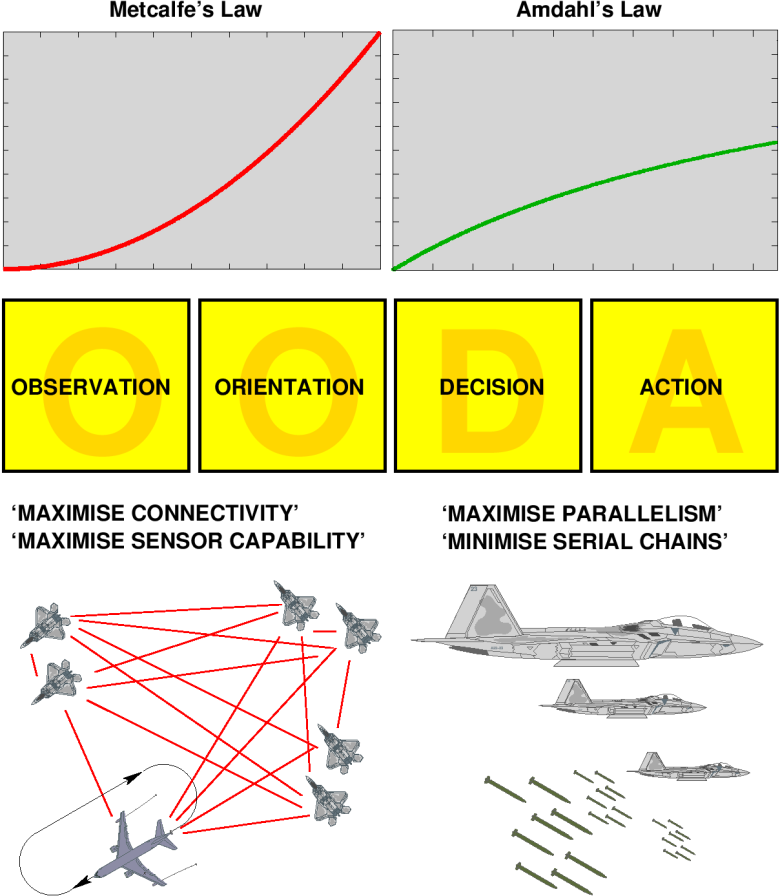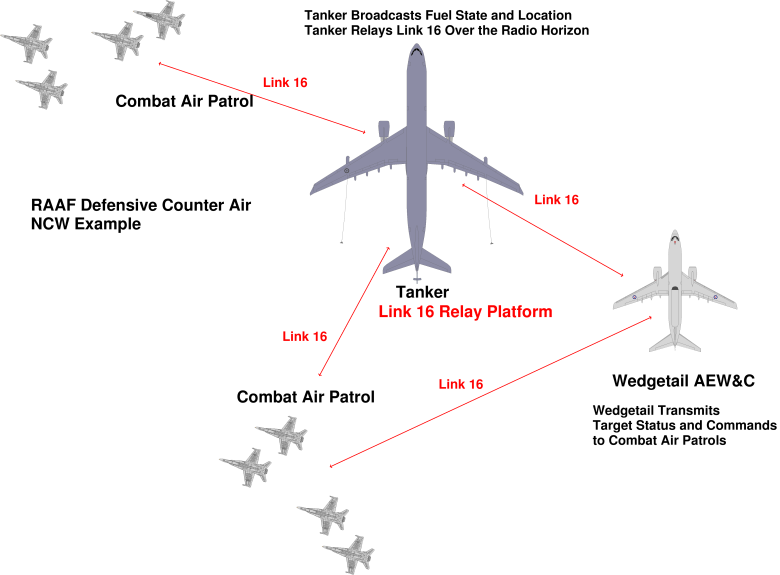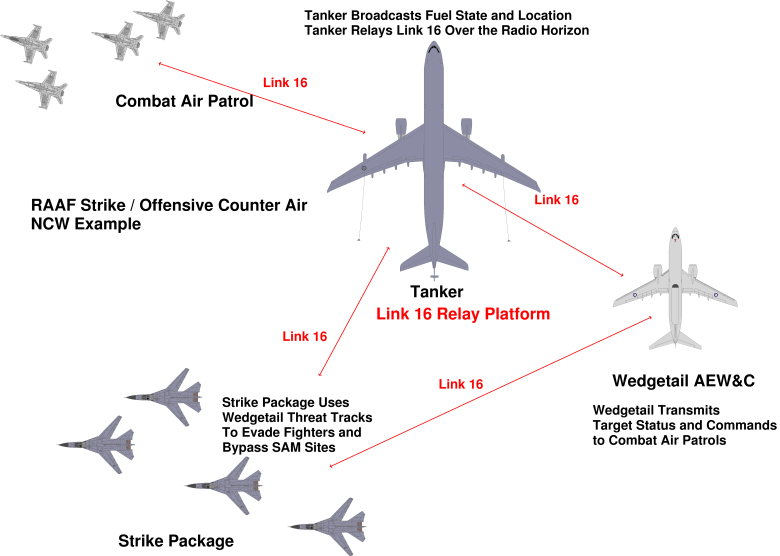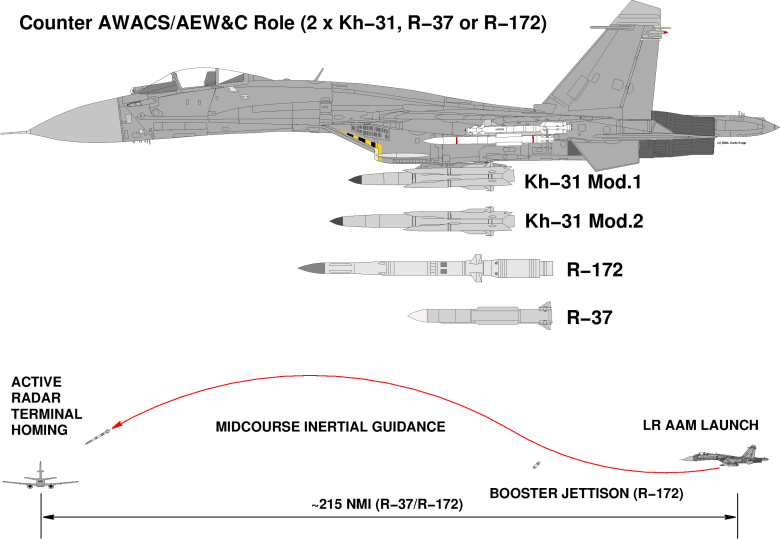Network Centric Warfare (NCW) is
the buzzword of choice in current Defence Department rhetoric. There is
little doubt that the introduction of NCW is the defining paradigm of
this decade in military affairs, and inevitably, we should see this
reflected in Australia. How well NCW is understood in Australia's DoD
is, however, another matter entirely.
From a broad perspective the introduction of networking
techniques into warfighting systems is the military equivalent of the
digitisation and networking drive we observed in Western economies
between 1985 and 1995. Military networking, especially between
platforms, is far more challenging than industry networking due to the
heavy reliance on wireless communications, high demand for security,
and
the need for resistance to hostile jamming. The demanding environmental
requirements for military networking hardware are an issue in their own
right. It should come thus as no surprise that the introduction of
networking into military environments has proven more painful and more
protracted than the industry experience of over a decade ago.
Why Networking?
Much has been written and said over the last decade as to why
networking is essential, and how it improves warfighting capability.
Unhappily, not all of the publications present robust arguments, and
much of what has been written has been accepted as fact, rather than
critically analysed.
At the most fundamental level networking aims to accelerate
engagement cycles and operational tempo at all levels of a warfighting
system. This is acheived by providing a mechanism to rapidly gather and
distribute targeting information, and rapidly issue directives. A high
speed network permits error free transmission in a fraction of the time
required for voice transmission, and permits transfer of a wide range
of
data formats.
In a more technical sense, networking improves operational
tempo (optempo) by accelerating the Observation-Orientation phases of
Boyd's Observation-Orientation-Decision-Action (OODA) loop. Identified
during the 1970s by US Air Force strategist John Boyd, the OODA is an
abstraction which describes the sequence of events whihc must take
place
in any military engagement. The opponnent must be observed to gather
information, the attacker must orient himself to the situation or
context, then decide and act accordingly. The OODA loop is thus
fundamental to all military operations, from strategic down to
individual combat. It loop is an inevitable part of reality and has
been
so since the first tribal wars of 25,000 years ago, as it is
fundamental
to any predator-prey interaction in the biological world. Sadly, its
proper understanding had to wait until the 1970s.
At a philosophical and practical level what confers a key
advantage in engagements is the ability to stay ahead of an opponent
and
dictate the tempo of the engagement - to maintain the initiative and
keep an opponent off balance. In effect, the attacker forces his
opponent into a reactive posture and denies the opponent any
opportunity
to drive the engagement to an advantage. The player with the faster
OODA
loop, all else being equal, will defeat the opponent with the slower
OODA loop by blocking or pre-empting any move the opponent with the
slower OODA loop attempts to make.
The four components of the OODA loop can be split into three
which are associated with processing information, and one which is
associated with movement and application of firepower.
Observation-Orientation-Decision are information centric while Action
is kinematic or centred in movement, position and firepower.
If we aim to accelerate our OODA loops to achieve higher
operational tempo than an enemy, we have to accelerate all four
components of the loop. Much of twentieth century warfighting technique
and technology dealt with accelerating the kinetic portion of the
OODA loop. Mobility, precision and firepower increases were the result
of this evolution.
There are practical limits as to how far we can push the
kinetic aspect of the OODA loop - more destructive weapons produce
collateral damage, faster platforms and weapons incur ever increasing
costs. Accordingly we have seen evolution slow down in this domain
since
the 1960s. Many weapons and platforms widely used today were designed
in
the 1950s may remain in use for decades to come, the B-52 being a good
case study.
Observation-Orientation-Decision are all about gathering
information, distributing information, analysing information,
understanding information and deciding how to act upon this
information.
The faster we can gather, distribute, analyse, understand information,
the faster we can decide, and arguably the better we can decide how and
when to act in combat. Networking is a mechanism via which the
Observation-Orientation phases of the loop can be accelerated, and the
Decision phase facilitated.
Well implemented networking can contribute to improved
effectiveness in other ways. One such technique is 'self
synchronisation' which permits 'directive control'. Rather than
micromanage a warfighting asset with close control via a command link
tether, warfighters are given significant autonomy, defined objectives,
and allowed to take the initiative in how they meet these objectives. A
fighter pilot who receives continuous updates from an AEW&C
aircraft
over a network can make his own tactical decisions, exploiting the
situational picture broadcast from the AEW&C aircraft. This is of
course not a new model, but networking facilitates it in ways difficult
to match - compare this example with the AM radio broadcasts issued in
1943-1945 by Luftwaffe air defence nodes to permit night fighters to
autonomously hunt for Allied bombers. Both amount to a 'self
synchronisation' scheme, but the underlying technology is five decades
apart.
Networking is not a panacea, nor can it be. The ultimate
limits on the combat effect produced by a warfighting system, and thus
is capability, are bounded by the Action or 'kinetic' phase of the
loop.
Bombs or missiles delivered is the bottom line, and networking is a
tool
to facilitate this effect, it is not a sustitute for bombs and missiles
on target as some proponents of NCW publicly advocate.
Until recently the mathematics underpinning capability gains
in large networked warfighting systems had not been studied closely.
Many scholars of NCW simply borrowed the well established Metcalfe's
Law
from the commercial domain and simply declared it to be valid for
military systems. Metcalfe's Law states that the 'utility' of a network
increases with the square of the number of nodes in the network - ten
nodes (platforms) permit a hundred possible connections, a hundred
nodes
ten thousand. Unfortunately the mathematics of web site driven sales
statistics are not particularly revelant to the behaviour of networked
military forces. What we now understand is that Metcalfe's Law presents
a possible best case scenario for distribution of information collected
by sensors on platforms in a military system. At best it is an
indicator
of gains in situational awareness, assuming the data being distributed
is valid, timely and relevant. The real limits to capability gains in
networked systems arise from the Decision-Action phases of the OODA
loop.
The Decision phase sees a commander exploiting knowledge
acquired in the Observation-Orientation phases, and conferring as
required with his superiors and subordinates to determine what is the
best choice of action. In the Action phase the commander must deploy
his
assets and effect the engagement. Both of these phases of the loop, in
mathematical terms, are queuing systems. The commander must wait for
others to respond, and must marshal and position assets to engage. All
of these events involve one entity waiting for another, in effect
queueing up.
The mathematical model which contrains such systems is
Amdahl's Law, like Metcalfe's Law a defining equation in the computer
industry. The reality Amdahl defines is simple - increasing the number
of assets in the system increases the achieved work or effect at best
only by the number of assets added. The actual improvement is limited
by
the queuing effects seen in marshalling and positioning assets to
perform engagements.
The mathematical bottom line in NCW is a very simple one:
networking can permit a significant improvement in operational tempo,
where a shortage of targeting information is the bottleneck to
achieving
a high operational tempo, but networking itself has very little impact
on the absolute ability of a force to deliver weapons against targets,
that being constrained by the capabilities and number of combat
platforms in use.

Networking can accelerate operational
tempo by speeding up the Observation and Orientation phases of Boyd's
OODA loop. Unfortunately the bounds on the capability of the 'system of
systems' are imposed by the Decision and especially Action phases of
the loop (Author).
A good example is the classic Desert Storm scenario of an air
force attacking strategic targets and in situ battlefield targets like
deployed armoured divisions. With ample targeting information,
especially for fixed targets, networking of the attacking force would
not have dramatically increased combat effect.
Accordingly we have seen networking produce its greatest
gains
in combat effect during battlefied strike and close air support
operations, especially against highly mobile and fleeting ground
targets. In such an environment, where the opponent is continuously on
the move, networking can produce spectacular gains since the bottlneck
limiting force capability lies in the flow of targeting information to
strike aircraft.
No less interesting are the effects observed in demand for
specific types of assets to support networked interdiction and strike
operations. Short targeting cycles in strike operations require that
the
bomber be orbiting in close proximity to the intended target - this is
persistent strike formally now labelled a killbox interdiction. In
practice this has driven up the demand for tanker sorties and the
demand
for B-52H, B-1B and F-15E - all at the expense of the smaller F-16C and
F/A-18 variants. Bigger is better in the networked strike game, so much
so that a recent discussion piece by US analyst Price Bingham in the
ISR
Journal predicted the demise of the classical battlefield
interdiction
tasked fighter-bomber, in favour of larger bombers and UCAVs. This is a
direct challenge to the basic rationale for the Joint Strike Fighter
family of battlefield interdiction and close air support fighters, and
the longer term use of legacy designs like the F-16 and F/A-18
variants.
Networking has produced other useful benefits. One is combat
identification and deconfliction, where the JTIDS/Link-16 system has
been used very effectively as a more capable substitute for
conventional
IFF, capable of supporting air, land and sea assets.
A key issue for all networking is the
Intelligence-Surveillance-Reconnaissance capability supporting it.
Networks like all computing systems obey the Garbage-In Garbage-Out
rule
- without accurate high quality ISR systems feeding the network, it is
little more than high speed digital plumbing between platforms, with
nothing useful to carry. In the US force structure, the pressure to
introduce network developed mostly due to bottlenecks in pushing ISR
derived targeting information out of existing ISR systems like AWACS,
JSTARS and Rivet Joint.
Networking capabilities are not confined to Western nations.
The diffusion of commercial computing and networking systems globally
has contributed to a growing in focus by non-Western militaries.
Russia has capitalised on this by aggressively marketing ISR platforms
like the A-50 AWACS, digital datalinking products - the Soviets were
deeply enamoured of digital air defence networks - and counter ISR
systems. The latter include long range AAMs like the R-172, R-37 and
Kh-31 variants, as well as airborne and land mobile high power jamming
equipment, and very long range SAMs like the S-400 and Imperator
series.
In summary the introduction of networking offers many
benefits
for an air force and should be actively pursued. It is however not a
substitute for combat or ISR capabilities in a force structure and
cannot be used as an excuse to justify downsizing of combat fleets.


The Technological
Perspective
The technology supporting NCW is inherently complex, but not
significantly moreso than the technology used to digitise and network
the civilian world. It must however be more resilient physically,
thermally, electrically and be better resistent to hostile penetration,
and in wireless systems, hostile jamming.
The prerequisite for an NCW capability is the digitisation of
combat platforms. A combat aircraft with a digital weapon system can be
seamlessly integrated in an NCW environment by providing digital
wireless connections to other platforms. Without the digital weapon
system, and its internal computers, NCW is not implementable. The
growing gap between the US military and the EU military largely
reflects
the Europeans' reluctance to heavily invest in digitising their combat
platforms.
Provision of digital wireless connectivity between combat
platforms is a major technical challenge which cannot be understated.
While civilian networking of computers can largely rely on cabled
links,
be they copper or optical fibres, with wireless connectivity as an
adjunct, in a military environment centred in moving platforms and
field
deployed basing, wireless connectivity is the central means of carrying
information.
The problems faced in providing military networking are
generally well understood, but often push the boundaries of available
technology. Key issues can be summarised thus:
This veritable menagerie of datalink modulations/protocols is
by no means exhaustive, but reflects the realities observed in the
computer industry in the decades predating the Internet. New protocols
like the Joint Tactical Radio System (JTRS) are in part intended to
incorporate mechanisms for translating such legacy protocols into
formats which can be sent over a common channel. Separate from these
multi-platform protocols and modulations are the type specific
datalinks, such as the intra- and interflight datalinks used on the
F/A-22A and later the JSF.
As yet there has been little effort to capitalise on the new
technology of ad hoc network protocols, designed for self organising
networks of mobile platforms, although the JTRS WNW effort looks
promising. The DARPA GLOMO program in the late 1980s saw considerable
seed money invested, but did not yield any publicised dramatic
breakthroughs. Ad hoc networking remains a yet to be fully explored
frontier in the networking domain, one which is apt to provide a
decisive technology breakthrough for NCW.
The technological issues in NCW often dominate the debate at
the expense of the deeper philosophical and functional issues which is
unfortunate, since both domains matter and getting either wrong results
in an equally disfunctional end result.
NCW and Australia
In Australia networking has been very much in the limelight
of
the defence debate. Sadly, it has also been used to justify a great
many
dubious decisions, all predicated on premises which do not hold.
Like most intellectually demanding and complex systems
problems, NCW must be properly understood before it can be used as a
basis for strategic planning decisions. Clearly this has not been the
case in many key areas of the DoD, resulting in public statements which
would be comical were not the circumstances so dire.
Perhaps the best exposition of this problem lies in the
package of submissions presented earlier this year to the JSCFADT
committee of Federal Parliament, especially the Air Combat Capability
paper.
In this document we learn that networking can substitute for
combat fleet numbers, despite the contrary experience in Afghanistan
and
Iraq, where aircraft size became the pivotal issue. We also learn that
the combat effect of the system should exceed the sum of its parts
despite the contrary mathematics underpinning this problem. Limitations
in the F/A-18A and JSF we learn do not matter, since Australia will
evidently have an asymmetric advantage in networking and AEW&C,
despite regional buys of Russian/Israeli A-50 AWACS, and Russian
marketing of TKS-2 digital datalinks on Su-30 fighters. We also learn
in
this document that AEW&C aircraft and networks will not be
challenged, as evidently Russian R-172, Kh-31 and R-37 missiles, or
high
power jammers, will never be used in the region - regional buys
notwithstanding. No differently, Australia need not invest in high
power
jamming aircraft since other nations will never use their AEW&C and
networking systems. We also learn that five A330-200 tankers will
improve the RAAF's combat persistence, since evidently the fuel carried
in F-111s need not be counted. No less surprisingly we also discover
that the mere AU$20M to 30M required to put networking into the F-111s
is unusually expensive and not worth doing - evidently it is better to
kill off the aircraft than invest into networking it.
The ugly reality is that networking has become a cure all
panacea in the DoD bureacratic machine, one which can magically offset
all force structure limitations, and one which magically only Australia
can possess and use properly in the Pacrim.
The analytical perspective is very different, however. Most
regional nations are now operating, deploying or shopping for AEW&C
aircraft. Russia is actively marketing digital datalinks, like the
TKS-2
and older APD-518, and marketing counter-ISR weapons like the Novator
R-172 (KS-172) or Kh-31 series missiles. Russia is also marketing high
power jamming equipment, especially pods using Digital RF Memory (DRFM)
technology, and there is a good prospect of a Growler-ski based on the
Su-32 materialising before the end of the decade.

In practical terms, by 2010-2015 regional opponents without
AEW&C, long range counter-ISR missiles and jamming pods are likely
to be the obliging exception to the rule. US thinking is not
surprisingly centred in using F/A-22As to sanitise airspace permitting
unhindered use of ISR platforms and networks, and the program to
replace
the lost capabilities of the EF-111A Raven with the B-52J or EB-52,
equipped with high power stand-off jamming equipment to disrupt
opposing
networks and ISR sensors.
The reality we observe
regionally and globally is, like the physics and mathematics which
apply
to the network problem, very different to the interpretation of these
issues which we observe in the confines of Russell Offices. The
Departmental leadership have effectively committed Australia to major
strategic decisions, like the JSF program and F-111 retirement, on the
basis of beliefs which are simply not supportable by fact. That a major
fraction of virtually every public document dealing with the JSF and
F-111 issues is dedicated to extolling the virtues of NCW is evidence
in
its own right.
The sad conclusion is that this
emotive rather than rational approach to NCW amounts to little more
than
a doctrinal and strategic heresy, one which will no doubt vanish into
oblivion no differently than the enthusiasm for the 'Revolution in
Military Affairs' did some years ago. Until that much awaited day
comes,
damage will continue to be done to Australia's basic capabilities.
![Home - Air Power Australia Website [Click for more ...]](APA/APA-Title-Main.png)
![Sukhoi PAK-FA and Flanker Index Page [Click for more ...]](APA/flanker.png)
![F-35 Joint Strike Fighter Index Page [Click for more ...]](APA/jsf.png)
![Weapons Technology Index Page [Click for more ...]](APA/weps.png)
![News and Media Related Material Index Page [Click for more ...]](APA/media.png)
![Surface to Air Missile Systems / Integrated Air Defence Systems Index Page [Click for more ...]](APA/sams-iads.png)
![Ballistic Missiles and Missile Defence Page [Click for more ...]](APA/msls-bmd.png)
![Air Power and National Military Strategy Index Page [Click for more ...]](APA/strategy.png)
![Military Aviation Historical Topics Index Page [Click for more ...]](APA/history.png)
![Intelligence, Surveillance and Reconnaissance and Network Centric Warfare Index Page [Click for more ...]](APA/isr-ncw.png)
![Information Warfare / Operations and Electronic Warfare Index Page [Click for more ...]](APA/iw.png)
![Systems and Basic Technology Index Page [Click for more ...]](APA/technology.png)
![Related Links Index Page [Click for more ...]](APA/links.png)
![Homepage of Australia's First Online Journal Covering Air Power Issues (ISSN 1832-2433) [Click for more ...]](APA/apa-analyses.png)
![Home - Air Power Australia Website [Click for more ...]](APA/APA-Title-Main.png)
![Sukhoi PAK-FA and Flanker Index Page [Click for more ...]](APA/flanker.png)
![F-35 Joint Strike Fighter Index Page [Click for more ...]](APA/jsf.png)
![Weapons Technology Index Page [Click for more ...]](APA/weps.png)
![News and Media Related Material Index Page [Click for more ...]](APA/media.png)
![Surface to Air Missile Systems / Integrated Air Defence Systems Index Page [Click for more ...]](APA/sams-iads.png)
![Ballistic Missiles and Missile Defence Page [Click for more ...]](APA/msls-bmd.png)
![Air Power and National Military Strategy Index Page [Click for more ...]](APA/strategy.png)
![Military Aviation Historical Topics Index Page [Click for more ...]](APA/history.png)
![Intelligence, Surveillance and Reconnaissance and Network Centric Warfare Index Page [Click for more ...]](APA/isr-ncw.png)
![Information Warfare / Operations and Electronic Warfare Index Page [Click for more ...]](APA/iw.png)
![Systems and Basic Technology Index Page [Click for more ...]](APA/technology.png)
![Related Links Index Page [Click for more ...]](APA/links.png)
![Homepage of Australia's First Online Journal Covering Air Power Issues (ISSN 1832-2433) [Click for more ...]](APA/apa-analyses.png)
![Sukhoi PAK-FA and Flanker Index Page [Click for more ...]](APA/flanker.png)
![F-35 Joint Strike Fighter Index Page [Click for more ...]](APA/jsf.png)
![Weapons Technology Index Page [Click for more ...]](APA/weps.png)
![News and Media Related Material Index Page [Click for more ...]](APA/media.png)
![Surface to Air Missile Systems / Integrated Air Defence Systems Index Page [Click for more ...]](APA/sams-iads.png)
![Ballistic Missiles and Missile Defence Page [Click for more ...]](APA/msls-bmd.png)
![Air Power and National Military Strategy Index Page [Click for more ...]](APA/strategy.png)
![Military Aviation Historical Topics Index Page [Click for more ...]](APA/history.png)
![Information Warfare / Operations and Electronic Warfare Index Page [Click for more ...]](APA/iw.png)
![Systems and Basic Technology Index Page [Click for more ...]](APA/technology.png)
![Related Links Index Page [Click for more ...]](APA/links.png)
![Homepage of Australia's First Online Journal Covering Air Power Issues (ISSN 1832-2433) [Click for more ...]](APA/apa-analyses.png)